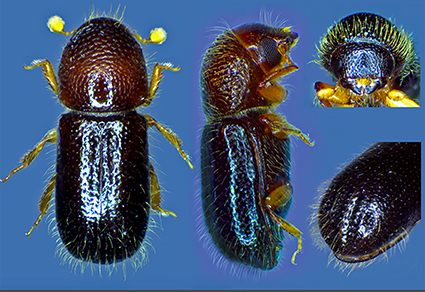Abstract
A new species of bark beetle, Dryocoetiops krivetsae Kerchev, Mandelshtam, Bykov et Ilinsky, sp. n., from the southern part of Primorsky Krai (Russian Far East), is described. This is the northernmost discovery of the Oriental genus Dryocoetiops Schedl, 1957, and the first record of the genus in the Russian fauna. Phylogenetic analysis of nuclear and mitochondrial genes i) confirms an independent lineage of Dryocoetiops krivetsae and ii) indicates numerous conflicts of genera relationships in the tribe Dryocoetini.
References
- Alonso-Zarazaga, M.A., Barrios, H., Borovec, R., Bouchard, P., Caldara, P., Colonnelli, E., Gültekin, L., Hlaváč, P., Korotyaev, B., Lyal, C.H.C., Machado, A., Meregalli, M., Pierotti, H., Ren, L., Sánchez-Ruiz, M., Sforzi, A., Silfverberg, H., Skuhrovec, J., Trýzna, M., Velázquez de Castro, A.J. & Yunakov, N.N. (2023) Cooperative catalogue of Palaearctic Coleoptera Curculionoidea. 2nd Edition. Monografías Electrónicas S.E.A. Vol. 14. Sociedad Entomológica Aragonesa S.E.A., Zaragoza, 780 pp.
- Alonso-Zarazaga, M.A. & Lyal, C.H.C. (2009) A catalogue of family and genus group names in Scolytinae and Platypodinae with nomenclatural remarks (Coleoptera: Curculionidae). Zootaxa, 2258 (1), 1–134. https://doi.org/10.11646/zootaxa.2258.1.1
- Baldo, L., Dunning Hotopp, J.C., Jolley, K.A., Bordenstein, S.R., Biber, S.A., Choudhury, R.R., Hayashi, C., Maiden, M.C., Tettelin, H. & Werren, J.H. (2006) Multilocus sequence typing system for the endosymbiont Wolbachia pipientis. Applied and Environmental Microbiology, 72 (11), 7098–7110. https://doi.org/10.1128/AEM.00731-06
- Beaver, R.A. & Browne, F.G. (1979) The Scolytidae and Platypodidae (Coleoptera) of Penang, West Malaysia. Oriental Insects, 12 (1978), 575‒624. https://doi.org/10.1080/00305316.1978.10432538
- Beaver, R.A., Smith, S.M. & Sanguansub, S. (2019) A review of the genus Dryocoetiops Schedl, with new species, new synonymy and a key to species (Coleoptera: Curculionidae: Scolytinae). Zootaxa, 4712 (2), 236–250. https://doi.org/10.11646/zootaxa.4712.2.4
- Blandford, W.F.H. (1894) The rhynchophorous Coleoptera of Japan. Part III. Scolytidae. Transactions of the Entomological Society of London, 42, 53–141. https://doi.org/10.1111/j.1365-2311.1894.tb02347.x
- Browne, F.G. (1961) The biology of Malayan Scolytidae and Platypodidae. Malayan Forest Records, 22, 1‒255.
- Bugrov, A.G., Ilinsky, Y.Y., Strunov, A., Zhukova, M., Kiseleva, E., Akimoto, S.I. & Tatsuta, H. (2016) First evidence of Wolbachia infection in populations of grasshopper Podisma sapporensis (Orthoptera: Acrididae). Entomological Science, 19 (3), 296–300. https://doi.org/10.1111/ens.12187
- Bykov, R., Kerchev, I., Demenkova, M., Ryabinin, A. & Ilinsky, Y. (2020) Sex-specific Wolbachia infection patterns in populations of Polygraphus proximus Blandford (Coleoptera; Curculionidae: Scolytinae). Insects, 11 (8), 547. https://doi.org/10.3390/insects11080547
- Choudhury, R. & Werren, J.H. (2006) Unpublished primers. s.n., s.l. [unknown pagination]
- Edgar, R.C. (2004) MUSCLE: multiple sequence alignment with high accuracy and high throughput. Nucleic Acids Research, 32 (5), 1792–1797. https://doi.org/10.1093/nar/gkh340
- Farrell, B.D. (1998) “Inordinate Fondness” explained: why are there so many beetles? Science, 281 (5376), 555–559. https://doi.org/10.1126/science.281.5376.555
- Farrell, B.D., Sequeira, A.S., O’Meara, B.C., Normark, B.B., Chung, J.H. & Jordal, B.H. (2001) The evolution of agriculture in beetles (Curculionidae: Scolytinae and Platypodinae). Evolution, 55 (10), 2011–2027. https://doi.org/10.1111/j.0014-3820.2001.tb01318.x
- Folmer, O., Black, M., Hoeh, W., Lutz, R. & Vrijenhoek, R. (1994) DNA primers for amplification of mitochondrial cytochrome c oxidase subunit I from diverse metazoan invertebrates. Molecular Marine Biology and Biotechnology, 3, 294–299.
- Johnson, A.J., McKenna, D.D., Jordal, B.H., Cognato, A.I., Smith, S.M., Lemmon, A.R., Lemmon, E.M. & Hulcr, J. (2018) Phylogenomics clarifies repeated evolutionary origins of inbreeding and fungus farming in bark beetles (Curculionidae, Scolytinae). Molecular Phylogenetics and Evolution, 127, 229–238. https://doi.org/10.1016/j.ympev.2018.05.028
- Jordal, B.H., Normark, B.B., Farrell, B.D. & Kirkendall, L.R. (2002) Extraordinary haplotype diversity in haplodiploid inbreeders: phylogenetics and evolution of the bark beetle genus Coccotrypes. Molecular Phylogenetics and Evolution, 23, 171‒188. https://doi.org/10.1016/S1055-7903(02)00013-1
- Kirejtshuk, A., Azar, D., Beaver, R., Mandelshtam, M. & Nel, A. (2009) The most ancient bark beetle known: A new tribe, genus and species from Lebanese amber (Coleoptera, Curculionidae, Scolytinae). Systematic Entomology, 34, 101–112. https://doi.org/10.1111/j.1365-3113.2008.00442.x
- Krivolutskaya, G.O. (1996) Family Scolytidae—bark-beetles. In: Ler, P.A. (Ed.), Keys to the insects of the Russian Far East. Vol. 3. Dal’nauka, Vladivostok, pp. 312–373. [in Russian]
- Kurentsov, A.I. (1941) The Bark Beetles of the USSR Far East. Izdatel’stvo Akademii Nauk SSSR, Moscow-Leningrad, 234 pp. [in Russian]
- Legalov, A.A. (2022) Fossil history of bark-beetles (Coleoptera: Scolytidae) with descriptions of two new species, Historical Biology. [published online] https://doi.org/10.1080/08912963.2022.2157275
- Ohno, S. (1990) The Scolytidae and Platypodidae (Coleoptera) from Borneo found in logs at Nagoya port. 1. Research Bulletin of the Plant Protection Service, Japan, 26, 83–94.
- Ohno, S., Yoneyama, K. & Nakazawa, K. (1986) The Scolytidae and Platypodidae (Coleoptera) from Sumatra and Mentawei Islands found in logs at Nagoya port. Research Report of the Nagoya Plant Protection Station, 25, 7–12.
- Pistone, D., Gohli, J. & Jordal, B.H. (2018) Molecular phylogeny of bark and ambrosia beetles (Curculionidae: Scolytinae) based on 18 molecular markers. Systematic Entomology, 43 (2), 387–406. https://doi.org/10.1111/syen.12281
- Simon, J.C., Boutin, S., Tsuchida, T., Koga, R., Le Gallic, J.F., Frantz, A., Outreman, Y. & Fukatsu, T. (2011) Facultative symbiont infections affect aphid reproduction. PLoS One, 6 (7), e21831. https://doi.org/10.1371/journal.pone.0021831
- Strohmeyer, H. (1911) Borkenkäfer der Philippinen. Philippine Journal of Science, D. General Biology, 6, 17‒27.
- Tamura, K., Stecher, G., Peterson, D., Filipski, A. & Kumar, S. (2013) MEGA6: molecular evolutionary genetics analysis version 6.0. Molecular Biology and Evolution, 30 (12), 2725–2729. https://doi.org/10.1093/molbev/mst197
- Wickham, H.F. (1916) New fossil Coleoptera from the Florissant Beds. Bulletin of the laboratories of natural history of the State University of Iowa, 7 (3), 3–20.
- Wood, S.L. (1986) A reclassification of the genera of Scolytidae (Coleoptera). Great Basin Naturalist Memoirs, 10, 1–126.


